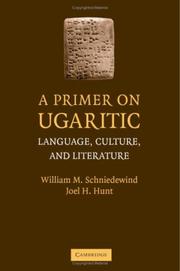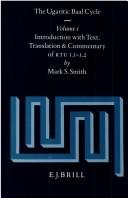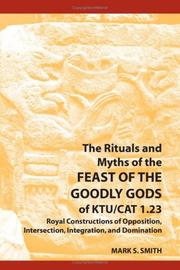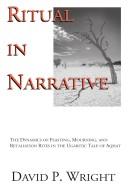| Listing 1 - 10 of 10 |
Sort by
|

ISBN: 9780521879330 9780521704939 9780511996962 0511349335 9780511349331 9780511350191 0511350198 0511996969 0521879337 0521704936 1107183812 9781107183810 1281086266 9781281086266 9786611086268 6611086269 0511351097 9780511351099 0511348363 9780511348365 0511574061 9780511574061 Year: 2007 Publisher: Cambridge Cambridge university press
Abstract | Keywords | Export | Availability | Bookmark
 Loading...
Loading...Choose an application
- Reference Manager
- EndNote
- RefWorks (Direct export to RefWorks)
A Primer on Ugaritic is an introduction to the language of the ancient city of Ugarit, a city that flourished in the second millennium BCE on the Lebanese coast, placed in the context of the culture, literature, and religion of this ancient Semitic culture. The Ugaritic language and literature was a precursor to Canaanite and serves as one of our most important resources for understanding the Old Testament and the Hebrew language. Special emphasis is placed on contextualization of the Ugaritic language and comparison to ancient Hebrew as well as Akkadian. The book begins with a general introduction to ancient Ugarit, and the introduction to the various genres of Ugaritic literature is placed in the context of this introduction. The language is introduced by genre, beginning with prose and letters, proceeding to administrative, and finally introducing the classic examples of Ugaritic epic. A summary of the grammar, a glossary, and a bibliography round out the volume.
Ugarit (Extinct city) --- Ugaritic philology --- Civilization --- Ugaritic philology. --- Ougarit (Extinct city) --- Raʼs Shamrah (Syria) --- Ras Shamra (Syria) --- Ugarit (Ancient city) --- Syria --- Civilization. --- Antiquities --- Arts and Humanities --- Religion
Book

ISBN: 1575065886 9781575065885 1575061430 9781575061436 9781575061436 Year: 2021 Publisher: University Park, PA
Abstract | Keywords | Export | Availability | Bookmark
 Loading...
Loading...Choose an application
- Reference Manager
- EndNote
- RefWorks (Direct export to RefWorks)
In the spring of 1928, a Syrian farmer was plowing on the Mediterranean coast near a bay called Minet el-Beida. His plow ran into a stone just beneath the surface. When he examined the obstruction, he found a large man-made flagstone that led into a tomb, in which he found some valuable objects that he sold to a dealer. Little did he know what he had discovered. In April of 1929, C. F. A. Schaeffer began excavation of the tombs, but a month later he moved to the nearby tell of Ras Shamra. On the afternoon of May 14, the first inscribed clay tablet came to light-thus the beginnings of the study of Ugarit and the Ugaritic language. Seventy-five years have passed, and the impact of this extraordinary discovery is still being felt. Its impact on biblical studies perhaps has no equal. In February 2005, some of the preeminent Ugaritologists of the present generation gathered at the Midwest Regional meetings of the American Oriental Society to commemorate these 75 years by reading the papers that are now published in this volume. The first five essays deal with the Ugaritic texts, while the last three deal with archaeological or historical issues.
Ugaritic literature --- History and criticism --- Ugarit (Extinct city) --- Ougarit (Extinct city) --- Raʼs Shamrah (Syria) --- Ras Shamra (Syria) --- Ugarit (Ancient city) --- Syria --- Antiquities --- Literatura ugarítica. --- Literatura ugarítica --- Història i crítica. --- Ugarit (Ciutat antiga) --- Congressos. --- Ugaritic literature - History and criticism - Congresses --- Ugarit (Extinct city) - Congresses --- History and criticism. --- Literatura semítica --- Poesia ugarítica --- Filologia ugarítica --- Ugarit (Síria : Ciutat antiga)

ISBN: 1282396854 9786612396854 9047442326 9789047442325 9004153489 9789004153486 9789004099951 9004099956 Year: 1994 Publisher: Leiden Brill
Abstract | Keywords | Export | Availability | Bookmark
 Loading...
Loading...Choose an application
- Reference Manager
- EndNote
- RefWorks (Direct export to RefWorks)
This second volume of the commentary on the Baal Cycle, the most important Canaanite religious text from Ugarit, in Syria, analyzes KTU/CAT 1.3 and 1.4, the tablets that contain the long episode about how Baal secured permission from El to build his royal palace and how the palace was built. It includes a new edition of the tablets, supplemented by a DVD-ROM with 92 images and superimposible drawings, a comprehensive introduction, new translation and vocalized text, and detailed commentary. The authors develop an interpretation of the episode which places it into the larger context of the Baal Cycle as a whole.
Baal (Divinité cananéenne) --- Ougaritique (Langue) --- Baal --- Baal Shamen --- Baal Shemin --- Bel --- Cycle de Baal. --- Ougarit (Ville ancienne) --- Ugarit (Extinct city) --- Religion. --- 299.23 --- Baal (Deity) --- 299.23 Oud-syrische godsdiensten. Ugaritische godsdienst --- Oud-syrische godsdiensten. Ugaritische godsdienst --- -Religion --- Ugarit (Extinct city) - - Religion --- -Baal (Deity) --- Baal (Canaanite deity)

ISBN: 1575065142 9781575065144 1575060299 9781575060293 9781575060293 Year: 2006 Publisher: Winona Lake Eisenbrauns
Abstract | Keywords | Export | Availability | Bookmark
 Loading...
Loading...Choose an application
- Reference Manager
- EndNote
- RefWorks (Direct export to RefWorks)
In 1929, a farmer accidentally discovered a tomb near the Mediterranean coast of Syria, about 12 km north of the modern seaport of Latakia. Initial excavations at the tell of Ras Shamra by René Dussaud and Claude Schaeffer brought to light impressive architectural remains, numerous artifacts, and tablets written in cuneiform (both alphabetic and syllabic), and the excavators soon were able to identify the site as the ancient city of Ugarit. Much of the material remains came to be dated to the end of the Late Bronze Age, from the 14th century through the 12th century B.C.E., and the religious, economic, and mythological texts from that era have had a major effect on our understanding of the history of the late 2nd millennium. However, by that time the site had already seen more than 6,000 years of occupation, and the data from Ras Shamra-Ugarit thus have become important as a reference point for the early history of the Near East along the Levantine coast and the eastern Mediterranean.In this volume, Marguerite Yon, the principal investigator since the early 1970s on behalf of the French archaeological team, brings us up to date on the 70-year-long excavation of the site. During the past 25 years, much of our understanding of the site itself has changed, due to new excavations, reexcavation, and reinterpretation of prior excavations. This volume is the authoritative latest word on the data from the site and their meaning for our understanding of the importance of ancient Ugarit.Heavily illustrated, including many black-and-white and color photographs.
Excavations (Archaeology) --- Ugarit (Extinct city) --- Ougarit (Extinct city) --- Raʼs Shamrah (Syria) --- Ras Shamra (Syria) --- Ugarit (Ancient city) --- Syria --- Antiquities --- 902 <394.4 UGARIT> --- 902 <394.4 UGARIT> Archeologie--Fenicië--UGARIT --- Archeologie--Fenicië--UGARIT --- Excavaciones arqueológicas --- Ugarit (Siria)
Book
ISBN: 3161550110 9783161550119 3161550102 9783161550102 Year: 2016 Publisher: Tübingen
Abstract | Keywords | Export | Availability | Bookmark
 Loading...
Loading...Choose an application
- Reference Manager
- EndNote
- RefWorks (Direct export to RefWorks)
Aren M. Wilson-Wright entwickelt eine neue Methode, um die Gottheiten des Vorderen Orients zu untersuchen. Der Schlüssel dieser Methode ist die Erkenntnis, dass die Rollen, Funktionen und die Darstellungen von göttlichen Wesen mit den Lebensweisen derer korrespondierten, die sie anbeteten.
Athtart (Semitic deity) --- Goddesses, Semitic. --- Astarte --- Egypt --- Syria --- Emar (Extinct city) --- Ugarit (Extinct city) --- Religion. --- Religion. --- Antiquities. --- Antiquities. --- Religion --- Ancient Near East --- Gods --- Altorientalistik --- Religionswissenschaft --- Altes Testament --- Antike Religionsgeschichte

ISBN: 1589833163 1429413735 9781429413732 9781589832039 1589832035 1589832035 9781589833166 Year: 2006 Publisher: Atlanta Society of biblical literature
Abstract | Keywords | Export | Availability | Bookmark
 Loading...
Loading...Choose an application
- Reference Manager
- EndNote
- RefWorks (Direct export to RefWorks)
Text of the work known as The birth of the beautiful gods, in parallel columns: Ugaritic (romanized) and English (p. 18-25), with commentary and discussion in English.
Gods, Ugaritic. --- Mythology, Ugaritic. --- Autumn festivals --- Death --- Eschatology --- Intermediate state --- Festivals --- Ugaritic mythology --- Ugaritic gods --- Religious aspects. --- Ugarit (Extinct city) --- Religion. --- Gods, Ugaritic --- Mythology, Ugaritic --- Ugaritic language --- 299.23 --- 299.23 Oud-syrische godsdiensten. Ugaritische godsdienst --- Oud-syrische godsdiensten. Ugaritische godsdienst --- Religious aspects --- Birth of the beautiful gods. --- Naissance des dieux gracieux et beaux --- Shahar and Shalim
Book
ISBN: 1575068850 9781575068855 1575068273 9781575068275 1575068354 9781575068350 9781575068275 Year: 2014 Publisher: Winona Lake, Indiana : Eisenbrauns,
Abstract | Keywords | Export | Availability | Bookmark
 Loading...
Loading...Choose an application
- Reference Manager
- EndNote
- RefWorks (Direct export to RefWorks)
Ugaritic literature --- Droughts. --- Death --- Eschatology --- Intermediate state --- Drought --- Drouth --- Drouths --- Weather --- Relation to the Old Testament. --- Religious aspects. --- Bible. --- Antico Testamento --- Hebrew Bible --- Hebrew Scriptures --- Kitve-ḳodesh --- Miḳra --- Old Testament --- Palaia Diathēkē --- Pentateuch, Prophets, and Hagiographa --- Sean-Tiomna --- Stary Testament --- Tanakh --- Tawrāt --- Torah, Neviʼim, Ketuvim --- Torah, Neviʼim u-Khetuvim --- Velho Testamento --- Ugarit (Extinct city) --- Sun --- Religion.
Book
ISBN: 9004415114 9004415106 Year: 2020 Publisher: Leiden Boston : BRILL,
Abstract | Keywords | Export | Availability | Bookmark
 Loading...
Loading...Choose an application
- Reference Manager
- EndNote
- RefWorks (Direct export to RefWorks)
"In The Amorite Dynasty of Ugarit Mary Buck takes a new approach to the field of Amorite studies by considering whether the site of Ugarit shares close parallels with other sites and cultures known from the Bronze Age Levant. When viewed in conjunction, the archaeological and linguistic material uncovered in this study serves to enhance our understanding of the historical complexity and diversity of the Middle Bronze Age period of international relations at the site of Ugarit. With a deft hand, Dr. Buck pursues a nuanced view of populations in the Bronze Age Levant, with the objective of understanding the ancient polity of Ugarit as a kin-based culture that shares close ties with the Amorite populations of the Levant. .
Amorites. --- Bronze age --- Excavations (Archaeology) --- Semitic languages, Northwest. --- Ugaritic language. --- Northern Central Semitic languages --- Northwest Semitic languages --- Northwestern Semitic languages --- Semitic languages, West --- Archaeological digs --- Archaeological excavations --- Digs (Archaeology) --- Excavation sites (Archaeology) --- Ruins --- Sites, Excavation (Archaeology) --- Archaeology --- Semitic languages, Northwest --- Ugarit (Extinct city) --- Ougarit (Extinct city) --- Raʼs Shamrah (Syria) --- Ras Shamra (Syria) --- Ugarit (Ancient city) --- Syria --- Antiquities. --- Antiquities
Book
ISBN: 1575066386 9781575066387 1575062062 9781575062068 9781575062068 9781575062075 1575062070 Year: 2011 Publisher: Winona Lake, IN Eisenbrauns
Abstract | Keywords | Export | Availability | Bookmark
 Loading...
Loading...Choose an application
- Reference Manager
- EndNote
- RefWorks (Direct export to RefWorks)
In a career spanning almost five decades, Baruch Levine's numerous publications reflect his wide-ranging interests and areas of expertise in the study of the Hebrew Bible, the ancient Near East, and early Judaism. In Pursuit of Meaning brings together 51 of the most important articles that Professor Levine produced during his years at Brandeis University (1962-69) and New York University (1969-2000, emeritus 2000-). The first volume, containing 27 articles, focuses on the study of religion in the biblical and ancient Near Eastern worlds from a number of perspectives, ranging from close philological analysis of written sources to anthropological studies of ancient cultic practices. In the 24 articles of the second volume, Levine engages broader aspects of ancient Near Eastern society, from legal institutions of various types to larger societal forms of organization. This volume also contains some of his more incisive lexicographical and philological contributions to the study of the Hebrew and Aramaic languages.The flavor of Prof. Levine's work is captured in this paragraph from his introduction to these two volumes:"Looking back, and reviewing my writings, I realize what it is that I have been seeking all along. I have been in pursuit of meaning, employing scholarly methods, primarily philology and semantics, to the exegesis of ancient Near Eastern texts, preserved in several languages, principally the Hebrew Bible. I regard language as the key to meaning. This conclusion would appear to be self-evident, and yet, philology is often sidelined in favor of engaging larger frameworks. Most of all, I challenge the notion that we already know the meaning of the words and clauses central to the texts under investigation, and may proceed directly to other considerations without first re-examining the smaller units. Again and again, that policy has resulted in flawed interpretation, and in missed opportunities for learning. This is not to say that scholars should stop at the smaller units, and, indeed, the tendency to do so has been largely responsible for the reaction against Semitic philology so noticeable since the latter part of the 20th century. It is our challenge to move outward from focal points to the circumference, from text to context, from content to structure."
Sacrifice --- Inscriptions, Aramaic --- Canaanites --- Cosmography. --- Hebrew language --- Cosmology --- Ethnology --- Semites --- Aramaic inscriptions --- Biblical teaching. --- Religion. --- Lexicography. --- Grammar. --- Balaam --- Balaam, --- Bilʻam --- Bileam --- Valaam --- בלעם --- Bible. --- Temple scroll. --- Megilat ha-Miḳdash --- מגילת־המקדש --- Dead Sea scrolls. --- Antico Testamento --- Hebrew Bible --- Hebrew Scriptures --- Kitve-ḳodesh --- Miḳra --- Old Testament --- Palaia Diathēkē --- Pentateuch, Prophets, and Hagiographa --- Sean-Tiomna --- Stary Testament --- Tanakh --- Tawrāt --- Torah, Neviʼim, Ketuvim --- Torah, Neviʼim u-Khetuvim --- Velho Testamento --- Criticism, interpretation, etc. --- Ugarit (Extinct city) --- Ougarit (Extinct city) --- Raʼs Shamrah (Syria) --- Ras Shamra (Syria) --- Ugarit (Ancient city) --- Syria --- Religious life and customs. --- Antiquities --- HISTORY / Ancient / General.

ISBN: 1575065231 9781575065236 1575060469 9781575060460 Year: 2021 Publisher: University Park, PA
Abstract | Keywords | Export | Availability | Bookmark
 Loading...
Loading...Choose an application
- Reference Manager
- EndNote
- RefWorks (Direct export to RefWorks)
Ugaritic ritual texts are varied and, by nature, problematic. But another source for ritual understanding is found in the narrative writings of Ugarit—namely, its myths and legends. Ritual texts in myths were not simply textual inserts but an integral part of the narrative. This present study is devoted to the examination of the way that ritual functions within the context of these stories.
Fasts and feasts --- Church festivals --- Ecclesiastical fasts and feasts --- Fast days --- Feast days --- Feasts --- Heortology --- Holy days --- Religious festivals --- Christian antiquities --- Days --- Fasting --- Liturgics --- Rites and ceremonies --- Theology, Practical --- Church calendar --- Festivals --- Holidays --- Sacred meals --- Religious aspects --- Aqhat epic. --- Aḳhat --- Sipur Aḳhat --- Legend of Aqhatu --- Aqhat --- Aqht --- Ob Akkhite --- On Aqhita --- Ugarit (Extinct city) --- Religion. --- Aqhat. --- Ugaritic language --- Legenden (teksten) --- Oegaritisch. --- Religion --- Fasts and feasts. --- 18.70 Semitic languages and/or literature. --- Religion, Primitive --- Atheism --- Irreligion --- Religions --- Theology --- Sources. --- Aqhat-Epos --- Aqhat-Mythos --- Epos --- Ugaritisch --- Syria --- Ougarit (Extinct city) --- Raʼs Shamrah (Syria) --- Ras Shamra (Syria) --- Ugarit (Ancient city) --- United Arab Republic --- Sirii︠a︡ --- Iqlīm al-Sūrī (United Arab Republic) --- Iqlīm al-Shamālī (United Arab Republic) --- Syrian Region (United Arab Republic) --- سوريا --- Sūriyā --- Jumhūrīyah al-ʻArabīyah al-Sūrīyah --- Syrian Arab Republic --- République arabe syrienne --- Sowria --- Syrie --- R.A.S. --- RAS --- Ittiḥād al-Duwal al-Sūrīyah --- Fédération des États de Syrie --- Syrische Arabische Republik --- SAR --- Suryah --- Arabska Republika Syryjska --- Syrien --- Jumhuriya al-Arabya as-Suriya --- Repubblica Araba Siriana --- جمهورية العربية السورية --- Jumhūriyyah al-ʻArabiyyah as-Sūriyyah --- Сірыя --- Siryi︠a︡ --- Сірыйская Арабская Рэспубліка --- Siryĭskai︠a︡ Arabskai︠a︡ Rėspublika --- Сирийската арабска република --- Siriĭskata arabska republika --- Συρία --- Αραβική Δημοκρατία της Συρίας --- Aravikē Dēmokratia tēs Syrias --- 시리아 --- Siria --- סוריה --- רפובליקה הערבית הסורית --- Republiḳah ha-ʻArvit ha-Surit --- シリア --- Shiria --- Сирия --- Сирийская Арабская Республика --- Siriĭskai︠a︡ Arabskai︠a︡ Respublika --- Сирія --- Syrii︠a︡ --- Сирійська Арабська республіка --- Syriĭsʹka Arabsʹka respublika --- 敘利亞 --- Xuliya --- Liturgy --- Antiquities --- Pseudoreligion --- Middle East --- Ugarit
| Listing 1 - 10 of 10 |
Sort by
|

 Search
Search Feedback
Feedback About UniCat
About UniCat  Help
Help News
News